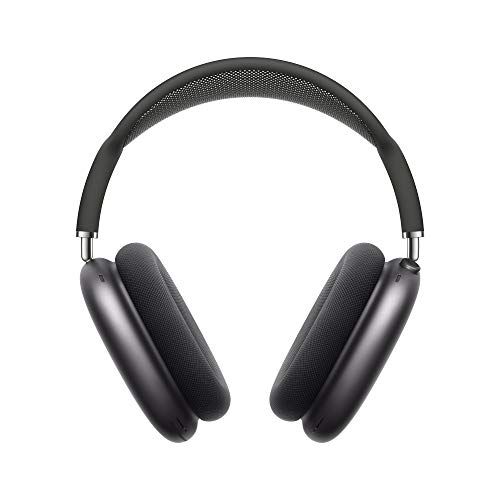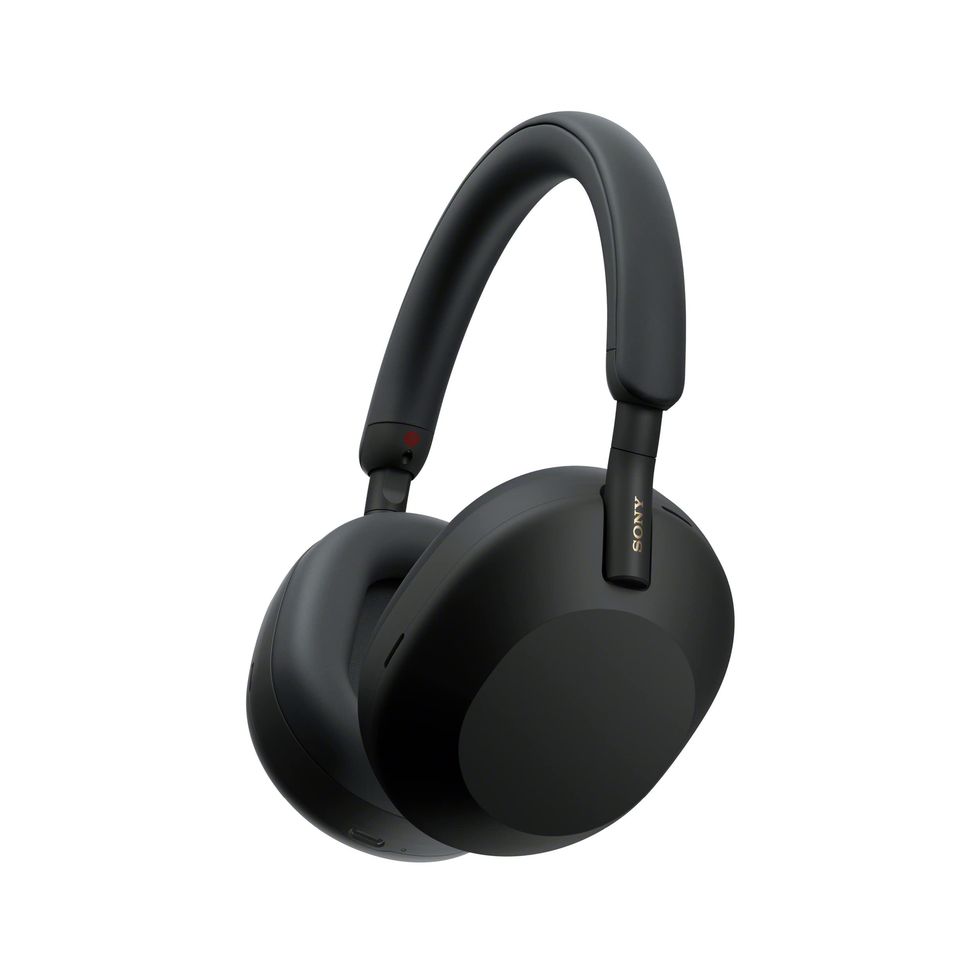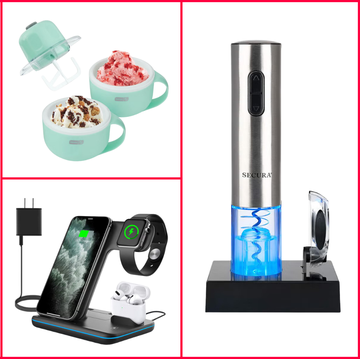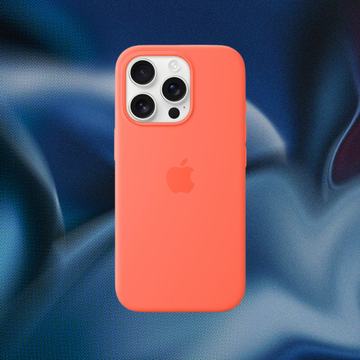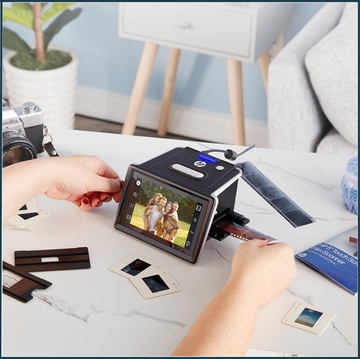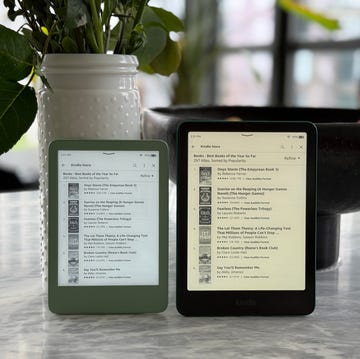Whether you're in the middle of an intense workout, walking the dog or on an important call at the office, there's nothing like a great pair of wireless headphones to help you stay connected. But if you're looking to completely tune out the entire world and its distractions, like chatty colleagues or pesky traffic sounds, search no further than over-ear noise-canceling headphones. These premium, tech-rich gadgets may seem like they're only for audiophiles or pilots, but that's just not the case. Noise-canceling headphones use counter soundwaves to block out the majority of background noise, making them as effective on a subway as at your local coffee shop (though keep in mind that certain sound frequencies are easier to cancel out than others).
Because you'll come across a lot of options when shopping for active noise-canceling (ANC) headphones, our pros went ahead and compared two of the most popular and top-performing models you can find today: the super sleek AirPods Max vs. the versatile Sony XM5.
The test engineers and product analysts at the Good Housekeeping Institute test all sorts of audio equipment so you can listen to music and take phone calls no matter where you are, including AirPod alternatives and cheap earbuds. As a longtime user of noise-canceling headphones and someone who won't board an airplane without them, I recently had the opportunity to test both the AirPods Max and the Sony XM5, taking each pair around NYC and on long-haul flights to get a better idea of how they compare when it comes to design and comfort, sound quality, noise cancellation capabilities, intuitiveness and more. Our Media & Tech Lab experts also stepped in to run audio and spectrum analysis software on both pairs to determine which headphones have the edge on performance.
Below you'll find everything you need to know about the AirPods Max vs. Sony XM5 to help you decide which pair is worth it for you.
AirPods Max vs. Sony XM5: Design
You can rely on Apple to create a stunning, sleek product like the AirPods Max. Unlike most headphones on the market, they're offered in five metallic shades so you don't have to stick to black if you don't want to. The breathable, easy-to-adjust mesh band should rest comfortably on most heads, while the soft ear pads create a snug seal from the outside world. Though I did find that the ear pads felt almost too snug during initial use, most people will quickly get used to this sensation (and they definitely beat wearing AirPods for hours at a time).
Admittedly, the Sony XM5's design isn't quite as attractive or innovative and you'll only have three standard matte colors to choose from: black, white or navy. I also noticed that this material is prone to collecting fingerprints and smudges, but that doesn't mean Sony's headphones don't have a lot going for them. During 8+ hours of international travel, I found the XM5 to be some of the most comfortable over-ear headphones I've ever worn, with super soft and plush synthetic leather ear pads. The headphones never felt too heavy or cumbersome.
Both the AirPods Max and Sony XM5 come in at under a pound so they're relatively lightweight and portable, yet the AirPods Max's extra few ounces make them feel heavier on the head. Avid travelers will likely prefer Sony's lighter design, along with their sturdy case that helps protect the headphones from being tossed around inside a backpack. Apple's case, on the other hand, is extremely minimalist and flimsy so it won't do much to protect your expensive headphones should something spill inside your bag or if you drop them on cement (it can happen).
One feature that I love about my go-to travel headphones, the Bose QuietComfort 45, is that they fold up inside their case to save even more space. Neither the Apple AirPods Max nor Sony XM5 offer this convenience, though I do give Sony bonus points for including a little compartment inside its case where you can safely store cables. But if you're looking for rugged headphones that will hold up to some heavy rain or gruesome sweat, you should probably look elsewhere. Neither the AirPods Max nor Sony XM5 are rated waterproof or weather-resistant so it's important to keep them clean and dry.
AirPods Max vs. Sony XM5: Ease of use
On-ear controls
Apple products are known and loved for being super easy to use and the AirPods Max are no exception. With only two physical controls (a button and a digital crown), it doesn't take long to figure out how they operate. The button controls noise cancellation allowing you to switch it on or off in a second. But what I love most is the digital crown, which has a few useful functions. To adjust the volume, all you need to do is give it a turn, or you can press down to pause your music, skip songs, access Siri and more.
Sony's on-ear controls are also fairly straightforward, with physical buttons on the left ear. One button is for turning the headphones on and off, while the other lets you go back and forth between noise cancellation and transparency mode. Unlike the AirPods Max, the right ear features touch controls. Swipe up or down to adjust the volume, double-tap to pause your music or swipe right to go to the next song.
While I like the concept of touch controls, I personally prefer physical buttons and find them easier to use. Because I'm a fidgety person, I kept touching the right ear of the Sony headphones on accident, which ended up being very frustrating when the TV show I was watching paused. It's certainly not a dealbreaker, but I would prefer on-ear controls that are similar to Apple's. One feature that I don't like about the AirPods Max, however, is that there's no on/off button. Though the headphones go into low-power mode when they're put back in their case, something about not being able to physically turn off a device feels wrong.
Connectivity
Apple users will find seamless connectivity with the AirPods Max, similar to what you'd experience with other AirPods. Whenever I took the headphones out of their case, they would immediately connect to my phone so I could (thankfully) avoid having to go into my phone's Bluetooth settings and force them to connect. Though the AirPods Max will work with Android devices, this connection isn't nearly as fluid — yet I was still impressed that they connected relatively quickly to my Google Pixel phone and I don't think being an Android user should stop you from purchasing the AirPods Max. Just keep in mind that only iOS users will have access to extra features such as Spatial Audio and Siri.
The Sony XM5 headphones are a great choice whether you're an Android or iOS user. In my experience, they connected automatically to my iPhone and Pixel most of the time. What's unique about the XM5 is that they feature Bluetooth multipoint connectivity, which means that you'll be able to connect to multiple devices and switch from one to the other, like when you have to take a personal call on your iPhone and then jump on a Zoom meeting on your PC.
Another striking difference between the two headphones is that the Apple AirPods Max do not come with a cable to connect to 3.5mm audio ports, which is what you typically need to use an in-flight entertainment system. For the hefty price of the headphones, Apple could have at least thrown in an audio cable like Sony.
AirPods Max vs. Sony XM5: Performance
Battery life
Having your headphones die on you is never convenient, so you'll want a pair with enough battery to last a few days at the office or at least throughout a long flight. For the best battery life, consider Sony. These headphones should last up to 30 hours with noise cancellation turned on, and 40 hours with it turned off, according to the brand. When using them, I felt like I never really needed to recharge, which is something frequent headphone users will appreciate.
The AirPods Max have a claimed battery life of up to 20 hours whether transparency mode is on or off. But because there's no on/off button on the headphones, I found that battery life drains a bit faster than expected. Even so, 20 hours should be plenty for most people.
Noise cancellation
Both the Apple AirPods Max and the Sony XM5 are some of the best noise-cancelling headphones on the market today. Whether I'm commuting to Manhattan or on a flight, I can't hear much of anything going on around me whenever they're on. In our most recent evaluations of 15 pairs of headphones at the Good Housekeeping Institute, both the AirPods Max and the XM5 earned some of the highest scores for noise cancellation. The Sony XM5 did outperform the AirPods Max slightly by more effectively blocking out pink noise, a sound with a consistent frequency that mimics hum and buzzes representative of the noise you try to filter out with noise-canceling headphones in real life. But unless noise cancellation is your number one priority (in which case you should consider the Bose 700), most consumers won't notice a drastic difference and should be pleased with either pair. "Both headphones were pretty robust and I was impressed by their ability to block out noise," says test lead and Lab assistant Nik Greenwald.
Transparency mode
Most headphones that feature noise cancellation also have a transparency mode, which is a feature that doesn't just turn off noise cancellation but actually uses mics to pick up outside sounds (like dialogue) to make it clearer and easier for you to hear. A transparency mode is extremely useful when you need to speak or listen to someone but don't want to take off your headphones, like when you're ordering a drink or need to tune into an announcement.
Though both the AirPods Max and the XM5 feature transparency modes, I found that the AirPods Max were more effective. When transparency mode is on, I can hear everything around me as if I wasn't even wearing headphones. In fact, when speaking to someone, I almost get the impression that I can hear better.
But the XM5 have one cool feature that Apple overlooked: speak to chat. Once you turn it on in the Sony Headphones Connect app, your headphones will automatically register when you're speaking and turn on transparency mode as well as pause your audio content so you can transition to a conversation. Though I did find speak-to-chat annoying at times, it's a useful feature to have if you work in a busy office environment and don't want to be constantly fiddling with an on/off button or taking off your headphones.
Sound quality
You can expect excellent sound quality from both the Apple AirPods Max and the Sony XM5, which earned top scores for audio performance when streaming music in our Lab tests. I have a slight preference for the clear, sharp sound of the AirPods Max, but the XM5 are pretty great as well.
According to our experts, the AirPods Max did a better job with higher frequencies and spoken content such as podcasts. Greenwald describes the overall sound quality as solid, with little distortion and impressive performance. The Sony XM5 were also a joy to listen to. "The sound quality is pristine with a frequency response that reminds me of my studio monitors," Greenwald says. He describes the sound as smooth with more noticeable bass. I actually love the way both headphones sound when playing music.
One feature audiophiles will love about the XM5 is that you can download the Sony Headphones Connect app to customize your listening experience by adjusting EQ settings to your liking. This creates a more immersive listening experience similar to Sony's 360 Reality Audio, which makes it feel like the sound from your headphones is surrounding you. On the AirPods Max, you can't adjust the way your audio sounds (though iPhone users can go into their settings to access features such as Spatial Audio).
Voice calling
If you've ever been on a phone call and had the person on the other line tell you that they can't hear you well, your headphones or earbuds might be to blame. To find out whether the AirPods Max or XM5 are better at picking up your voice (and removing unnecessary background noise like wind, construction, etc.) while on the phone, I called family and friends while commuting to the Good Housekeeping Institute in NYC. All callers on the other end of the line told me that my voice sounded loud and crystal clear when wearing the Sony, and much more muffled and distant when wearing the AirPods Max. So, if you're someone who takes a lot of Zoom meetings or phone calls on the go, the Sony XM5 could be the better choice for you.
Bottom line: Which noise-canceling headphones are right for you?
At the end of the day, you really can't go wrong with the Apple AirPods Max or the Sony XM5. Both pairs of headphones are absolutely fantastic and have fairly similar performance with some slight differences, so your decision will have to come down to what you value most. If it's battery life, portability and saving some money, you're better off choosing Sony. If its sleek design, seamless connectivity to your iPhone and intuitive controls, Apple is the way to go.
I go back and forth between which pair I prefer, though I tend to sway toward the Sony XM5 when traveling and the Apple AirPods Max at home. I love how I feel like a rockstar when wearing the AirPods Max. The digital crown is super easy to use, and I'm definitely a fan of their crisp sound. Though both headphones end up feeling a bit hot after a while, the Sony XM5 feel so much lighter and more comfortable during extended use. I also appreciate how they actually come with a proper case. If you want the best value, it's hard to do better than the Sony XM5. But if you love Apple products, then it might just be worth shelling out a bit more for the AirPods Max.
Why trust Good Housekeeping?
Media & Tech Reviews Analyst Olivia Lipski oversees product testing and covers consumer electronics, travel, fitness and more for Good Housekeeping. She continues to stay on top of the industry's latest innovations and helps readers make better buying decisions by testing and reviewing the best gadgets to hit the market. Since joining the Institute in 2021, she has tested at least 25 pairs of earbuds and headphones per year, rotating them out as she walks her dog or commutes to the Hearst Tower.
The Good Housekeeping Institute’s Lab Assistant, Nik Greenwald, ran the most recent test of noise-canceling headphones, spending over 20 hours researching, recording and analyzing data to compare different models. When not at the Institute, Greenwald works as a songwriter and record producer, having written and produced several tracks that have garnered millions of streams worldwide.
Olivia (she/her) is a senior reviews writer and analyst at the Good Housekeeping Institute, where she tests and writes about tech, home, travel, fitness, parenting and health products. Since joining GH in 2021, she has continued to leverage her extensive product reviews experience by staying on top of the industry’s latest innovations and helping readers make better buying decisions. Olivia is a graduate of the George Washington University, with a bachelor’s degree in journalism, political science and French, and she holds a master’s degree in communications from Sciences Po Paris.
As a data engineer in the Good Housekeeping Institute, Nik (he/him) works with all of our Labs to develop testing protocols and manage data collection and analysis. Before joining Good Housekeeping in 2022, Nik worked in the labs of MIT and Regeneron, working on projects ranging from chemical inventory and reporting to the development of bioassays. He holds a degree in chemical engineering from Northeastern University.



